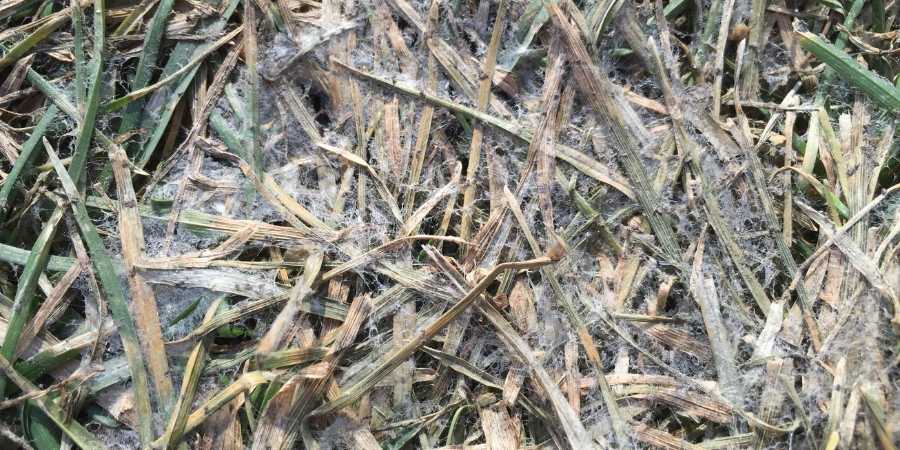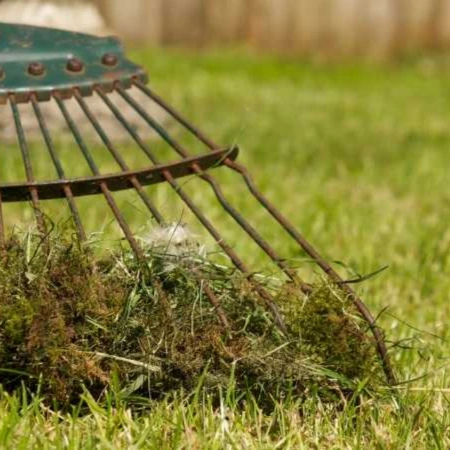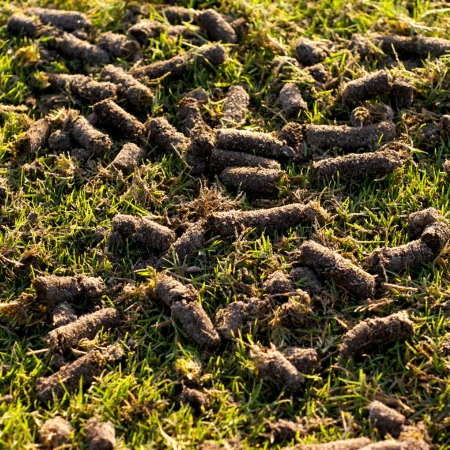What Shouldn't I do to My Lawn in Spring?
- Milorganite AgronomistApril 12, 2025
No matter where in the country you live spring is the time to assess your lawn and soil to prepare for the season ahead. Here are several things we don’t want you to do or forget to do for a healthier lawn, landscape, and garden this spring. Check out this map if you need help determining if you have cool-season or warm-season grass.
Don’t neglect your lawn mower.
Take your mower in for a tune-up, particularly to sharpen the blade! Dull blades tear grass blades leaving them susceptible to disease and drying out, which is why a sharp blade is so important. If you’re more of a DIY person, we have suggestions for maintaining your mower. It’s also a good time to take a look at all of your garden tools. Maintain, repair, and replace as necessary.
Don’t let pests ruin your landscape!
Diseases, pests, and insects may have made their winter homes in the mulch in your landscaping. Remove any diseased or suspected mulch and replace it. If the mulch is okay, you can supplement it to a depth of 3-4”.
Northern Region - Cool-Season Grasses
Jump to Southern Region, Warm-Season Grasses
Don’t leave snow on the lawn.
If you’ve had a lot of snow in your area this past winter, you may still have piles of melting snow. Lingering snow can suffocate the grass beneath as well as cause snow mold. Speed-up melting by raking or shoveling to spread the remaining snow.

Don’t walk on water-saturated lawns.
“Don’t tread on me” was the now-familiar motto on an American Revolution flag, and it’s also my suggestion for protecting your lawn this spring.
Lawns are often saturated with water in spring from melting snow and rain. Heavy traffic significantly compresses the soil and damages sprouting grass. Avoid a lot of walking or playing on your lawn until it’s had an opportunity to dry out.
Don’t forget to rake your lawn to evaluate its condition.
Lightly raking your lawn in spring is a great way to examine its state. It removes winter debris and allows you to identify trouble spots, thin or bare patches, and damage caused by diseases, pests, and insects. It’s also a good idea to rake before you start mowing or fertilizing. It will help get Milorganite into the soil and nourish your lawn more quickly.
Skip dethatching your lawn in spring.
Spring is the least desirable time to use a power-dethatcher to rid your lawn of that layer of dead plant material that’s on the surface of the soil. The best time to dethatch cool-season, northern grasses is late summer to early fall, when the grass is actively growing. Wait until the growing season is winding down to dethatch your lawn.

Don’t seed or patch bare spots in your lawn too early.
It’s the first warm spring weekend, and you’re excited to get out into the yard. You've noticed bare spots in your lawn that need to be re-seeded. But is it time to patch those bare spots with seed? No.
If bare spots are patched too early in spring, there’s the potential for a heavy frost or even worse—snow—to kill the newly germinated grass seed. In Wisconsin, we can be surprised by a mid-April snowfall, which can kill newly germinated grass seed (yes, this happened to me, ugh.)
Bare patches should be overseeded in the early- (but not too early) to mid-spring to allow the new grass to establish itself after the threat of freezing and before the summer heat.
Don’t fertilize your lawn too soon in spring.
Fertilizing your lawn too early in spring encourages grass to focus on shoot growth at the expense of growing strong roots. Deep roots help your lawn better withstand drought conditions in the heat of summer.
Fertilize your lawn with Milorganite in mid-May after the last chance of frost or freezing has passed, generally when daytime temperatures are consistently in the 60s and soil temperatures are in the mid-50s. Check out this site, which allows you to check the soil temperature in your zip code. As a rule of thumb, we suggest fertilizing your lawn with Milorganite around Memorial Day.
South Region - Warm-Season Grasses
Don't let thatch stifle your lawn.

About a half-inch of thatch is helpful. It helps maintain soil moisture and temperature. Thicker thatch can block water, air, and nutrients from reaching the roots. The best time to dethatch your warm-season grasses is in late spring using a power dethatcher.
Don’t forget to aerate your southern lawn.
Grass needs air and good drainage, so it’s important to aerate your lawn regularly. Warm-season grasses are best aerated in early- to mid-summer when the grass is actively growing and can quickly recover from the aeration process. As a rule of thumb, aerate after you’ve mowed the lawn 2–3 times.
If your soil looks more like the shore or a kid’s sandbox, don’t worry about aeration. Sandy soil had more than enough air and drainage capacity.
Don’t forget to condition the soil in spring.
Spring is the ideal time to amend and condition the soil of your lawn, landscape, and garden by adding organic matter, especially if you have sandy soil. Organic matter, including Milorganite, conditions the soil so that it’s better able to hold moisture. Materials to consider include compost, composted manure, peat moss… Grasscycling —leaving grass clippings on the lawn—is another way to regularly add organic matter to your lawn. It’s preferable to amend soil after aerating.
Don’t forget to feed your lawn! It’s hungry!
Don’t skip fertilizing in spring. Warm-season grasses can be fertilized with Milorganite around Easter and again around Memorial Day. Its slow-release nitrogen will continue to feed your lawn for weeks. Follow an annual fertilization schedule to maintain a healthy lawn. Always follow municipality fertilization guidelines.
Don’t forget to have your soil tested.
Spring is a good time to have your soil tested to check nutrient and pH levels. You can test the soil yourself using a store-bought kit or contact your local extension, which probably offers soil testing.
Knowing the nutrient levels will help you plan this season’s fertilization to ensure you’re adding needed nutrients at the right amount and avoiding excess fertilization, which can cause nutrient runoff. Milorganite is a good, slow-release nitrogen fertilizer that minimizes the risk of nutrient runoff.
Grass grows well in slightly acidic soil, between 7.0–6.5 pH, allowing it to properly absorb nutrients. Sulfur is more acidic and is used to lower the soil's pH. Lime can be used for acidic soil to raise the pH, so the plant roots can absorb the necessary nutrients from the soil. Only amend your soil if it needs it and only at the recommended rates. Compost can naturally correct pH, which also adds nutrients and conditions soil to remain moist.
Spring is the time to prepare for the growing season ahead. Every aspect of lawn care has a season. We’ve given you a list of several things to not do or neglect to do to prepare for a lush, green lawn this coming summer.

